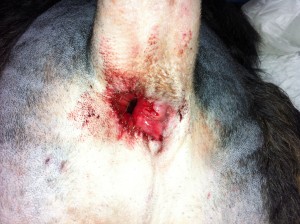This condition involves the formation of draining tracts around the anus. It is often seen in German Shepherd dogs, and causes discomfort and straining with defaecation.
It usually doesn’t respond to antibiotics. However treatment with cyclosporin, an immune suppressing drug, is often effective in reducing signs or putting the condition into remission. When treatment stops, signs can flare up again. Unfortunately this medication is expensive, and long term treatment in large dogs (requiring more of the drug than small ones) often proves very costly for owners.
Prior to the end of the 1990s, this disease was generally treated surgically. Since then, when cyclosporin treatment was found to be effective, surgery has generally been reserved for refractory cases or for cases where small localised areas of problem are present.
Surgical treatment involves cutting out the affected tracts with associated anal sphincter muscle. Anal gland(s) are often removed in association. The nerve supply to the anal sphincter controls faecal continence and if the innervation to both sides is compromised, there will be long term faecal incontinence post-operatively which may result in faecal soiling in the house. If just one side is damaged, faecal incontinence is likely to be transient and to resolve when scar tissue on the operated side gives the remaining muscle on the other side something to pull against.
21st July 2014



